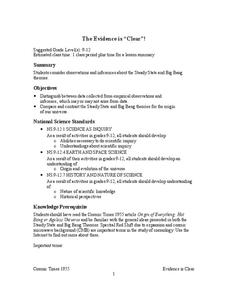Curated OER
Red Shift, Blue Shift
Pupils demonstrate how stellar spectra measures a star's motion relative to Earth along the line of sight.
International Technology Education Association
Singin' the Black and Blues
How does the color of the sky change from blue to reds and oranges to black? An illuminating lesson explains how light travels through different mediums using the sun's light as an example. By examining diagrams and illustrations, pupils...
Amani Project
Teach the Mood Meter
The third activity from the Amani Project has youths create a Mood Meter. The colorful meter, divided into red, yellow, blue, and green squares, lets participants indicate not only how they are feeling but also permits them to indicate...
Curated OER
Doppler Effect Worksheet
In this Doppler Effect worksheet, students answer questions about the movement of stars and the reason we see differences in the color of the stars resulting in a red shift or a blue shift.
Curated OER
The Spectroscope Lab
In this spectroscope worksheet, students observe fluorescent and incandescent lights through the spectroscope. They record their observations and observe spectra of elements. They answer questions about the chemical make-up of stars...
Noyce Foundation
Mixing Paints
Let's paint the town equal parts yellow and violet, or simply brown. Pupils calculate the amount of blue and red paint needed to make six quarts of brown paint. Individuals then explain how they determined the percentage of the brown...
Curated OER
The Doppler Effect Lab
In this Doppler effect worksheet, students read information about the Doppler effect. Students answer questions as it relates to the pitch and wavelengths of a demonstration simulates what happens with the Doppler Effect.
Curated OER
Introduction to Microsoft Word
Second graders elaborate on the classroom writing practices. They locate the various parts of the keyboard such as, space bar, shift key, delete key, etc. They also type a short piece of writing on a word processor. This is a teacher...
Virginia Department of Education
Modeling the Big Bang Theory
Young astronomers learn about the Big Bang Theory and redshift through a hands-on activity in the last installment of a three-part series. Participants draw dots on balloons and then inflate them to model how galaxies moved farther apart...
NASA
The Evidence is “Clear”!
Do you think you know better? Become a scientist and prove it. Scholars review the evidence for two different theories of the origins of the universe. They notice the empirical observations as well as the inferences to determine which is...
Curated OER
Chemical Consequences of Burning Fossil Fuels
Future scientists are introduced to the chemical consequences of burning fossil fuels, learning that fossil fuel combustion leads to the formation of oxides of three nonmetals: carbon, nitrogen, and sulfur, all of which end up in the...
Mr. E. Science
Stars, Galaxies and the Universe
It takes 225 million years for our sun to travel around the galaxy. The presentation covers astronomical units, light years, telescopes, types of stars, the life cycle of a star, and types of galaxies. This is the last lesson in a...
Curated OER
Acids, Bases and Indicators
High schoolers investigate the pH of various solutions with indicators. For this acids, bases and indicators lesson plan, students use a variety of indicators to test solutions for their pH. High schoolers determine which indicators are...
Curated OER
Star Chart
In this space science activity, students name the constellations for the location of stars and answer some related questions.
PBS
Pbs Teachers: The Dark Side of the Universe: Doppler Shift [Pdf]
Investigate how astronomers detect movements of stars by studying the Doppler effect on the star's light spectrum. Construct a model that illustrates this concept underlying red shift.
















![Pbs Teachers: The Dark Side of the Universe: Doppler Shift [Pdf] Lesson Plan Pbs Teachers: The Dark Side of the Universe: Doppler Shift [Pdf] Lesson Plan](https://content.lessonplanet.com/knovation/original/120528-27b1e0832d6ded7211396a70c5d6c972.jpg?1661407624)